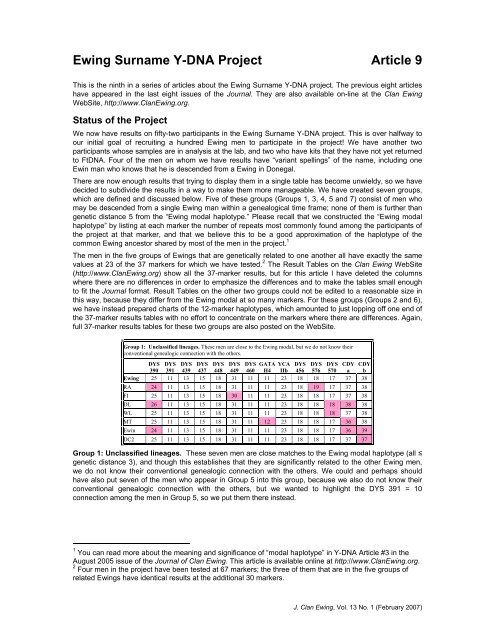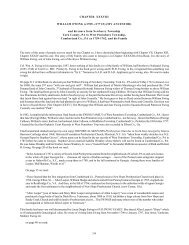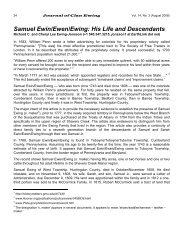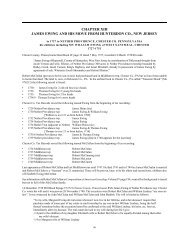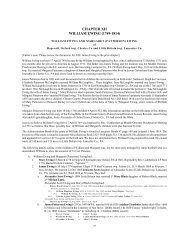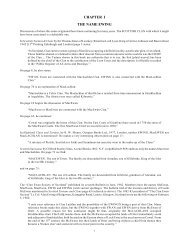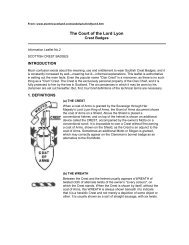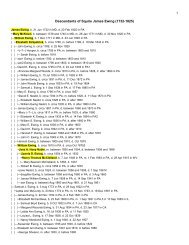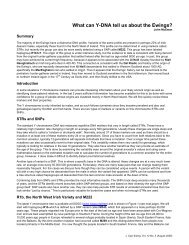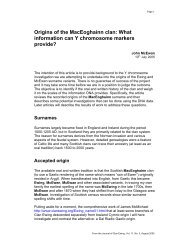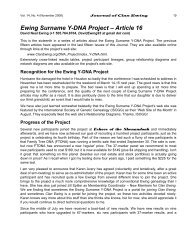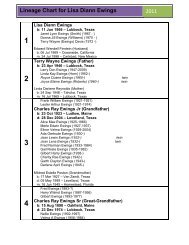Ewing Surname Y-DNA Project Article 9 - Ewing Family Association
Ewing Surname Y-DNA Project Article 9 - Ewing Family Association
Ewing Surname Y-DNA Project Article 9 - Ewing Family Association
Create successful ePaper yourself
Turn your PDF publications into a flip-book with our unique Google optimized e-Paper software.
<strong>Ewing</strong> <strong>Surname</strong> Y-<strong>DNA</strong> <strong>Project</strong> <strong>Article</strong> 9This is the ninth in a series of articles about the <strong>Ewing</strong> <strong>Surname</strong> Y-<strong>DNA</strong> project. The previous eight articleshave appeared in the last eight issues of the Journal. They are also available on-line at the Clan <strong>Ewing</strong>WebSite, http://www.Clan<strong>Ewing</strong>.org.Status of the <strong>Project</strong>We now have results on fifty-two participants in the <strong>Ewing</strong> <strong>Surname</strong> Y-<strong>DNA</strong> project. This is over halfway toour initial goal of recruiting a hundred <strong>Ewing</strong> men to participate in the project! We have another twoparticipants whose samples are in analysis at the lab, and two who have kits that they have not yet returnedto Ft<strong>DNA</strong>. Four of the men on whom we have results have “variant spellings” of the name, including oneEwin man who knows that he is descended from a <strong>Ewing</strong> in Donegal.There are now enough results that trying to display them in a single table has become unwieldy, so we havedecided to subdivide the results in a way to make them more manageable. We have created seven groups,which are defined and discussed below. Five of these groups (Groups 1, 3, 4, 5 and 7) consist of men whomay be descended from a single <strong>Ewing</strong> man within a genealogical time frame; none of them is further thangenetic distance 5 from the “<strong>Ewing</strong> modal haplotype.” Please recall that we constructed the “<strong>Ewing</strong> modalhaplotype” by listing at each marker the number of repeats most commonly found among the participants ofthe project at that marker, and that we believe this to be a good approximation of the haplotype of thecommon <strong>Ewing</strong> ancestor shared by most of the men in the project. 1The men in the five groups of <strong>Ewing</strong>s that are genetically related to one another all have exactly the samevalues at 23 of the 37 markers for which we have tested. 2 The Result Tables on the Clan <strong>Ewing</strong> WebSite(http://www.Clan<strong>Ewing</strong>.org) show all the 37-marker results, but for this article I have deleted the columnswhere there are no differences in order to emphasize the differences and to make the tables small enoughto fit the Journal format. Result Tables on the other two groups could not be edited to a reasonable size inthis way, because they differ from the <strong>Ewing</strong> modal at so many markers. For these groups (Groups 2 and 6),we have instead prepared charts of the 12-marker haplotypes, which amounted to just lopping off one end ofthe 37-marker results tables with no effort to concentrate on the markers where there are differences. Again,full 37-marker results tables for these two groups are also posted on the WebSite.Group 1: Unclassified lineages. These men are close to the <strong>Ewing</strong> modal, but we do not know theirconventional genealogic connection with the others.DYS DYS DYS DYS DYS DYS DYS GATA YCA DYS DYS DYS CDY CDY390 391 439 437 448 449 460 H4 IIb 456 576 570 a b<strong>Ewing</strong> 25 11 13 15 18 31 11 11 23 18 18 17 37 38RA 24 11 13 15 18 31 11 11 23 18 19 17 37 38FI 25 11 13 15 18 30 11 11 23 18 18 17 37 38DL 26 11 13 15 18 31 11 11 23 18 18 18 38 38WL 25 11 13 15 18 31 11 11 23 18 18 18 37 38MT 25 11 13 15 18 31 11 12 23 18 18 17 36 38Ewin 24 11 13 15 18 31 11 11 23 18 18 17 36 39DC2 25 11 13 15 18 31 11 11 23 18 18 17 37 37Group 1: Unclassified lineages. These seven men are close matches to the <strong>Ewing</strong> modal haplotype (all ≤genetic distance 3), and though this establishes that they are significantly related to the other <strong>Ewing</strong> men,we do not know their conventional genealogic connection with the others. We could and perhaps shouldhave also put seven of the men who appear in Group 5 into this group, because we also do not know theirconventional genealogic connection with the others, but we wanted to highlight the DYS 391 = 10connection among the men in Group 5, so we put them there instead.1 You can read more about the meaning and significance of “modal haplotype” in Y-<strong>DNA</strong> <strong>Article</strong> #3 in theAugust 2005 issue of the Journal of Clan <strong>Ewing</strong>. This article is available online at http://www.Clan<strong>Ewing</strong>.org.2 Four men in the project have been tested at 67 markers; the three of them that are in the five groups ofrelated <strong>Ewing</strong>s have identical results at the additional 30 markers.J. Clan <strong>Ewing</strong>, Vol. 13 No. 1 (February 2007)
Group 2: Singletons. These men do not appear to be related to any others in the project.DYS DYS DYS DYS DYS DYS DYS DYS DYS DYS DYS DYS393 390 19 391 385a 385b 426 388 439 389-1 392 389-2<strong>Ewing</strong> 13 25 15 11 11 13 12 12 13 13 14 29JMc 13 24 14 11 11 15 12 12 13 13 13 29TD 13 25 14 11 11 13 12 12 12 13 14 29MK 13 24 14 10 11 16 12 12 13 13 13 30SL 13 24 14 10 11 14 12 12 12 13 13 29Js 13 23 14 10 11 14 12 12 12 13 14 30Ewen 13 24 14 10 11 15 12 12 12 14 13 30WM 14 22 16 10 14 14 11 13 11 12 12 29JD 14 26 15 11 13 16 11 13 11 12 11 28Ewan 14 26 15 11 13 16 11 13 11 12 11 28Note: This chart is like the chart for Group 6 and unlike the other charts in this article, because the columndesignations are different. These charts show 12-marker haplotypes.Group 2: Singletons. This group includes the three men with “variant spellings” of the surname that are notknown to be descended from a specific <strong>Ewing</strong>: one McEwan, one Ewan and one Ewen, as well as six <strong>Ewing</strong>men. These nine men are not related genetically to any of the others in the project. They are also not relatedto one another, except possibly for one <strong>Ewing</strong> man and the Ewan man, who match exactly on all 12 of themarkers the Ewan man was tested for. This is suggestive, but it is not uncommon for 12 markers to matchby coincidence in unrelated men with Scottish surnames. If we could persuade the Ewan man to upgrade to37 markers and there was still a close match, then we could say with some confidence that these two menare related and that there must have been a change in the spelling of the name of one or the other of thesetwo men somewhere along the line.The Group 2 table included in this article has been edited to show only the 12-marker haplotypes, becausedisplaying 37-marker results does not work well with the Journal format. Full results are available on theClan <strong>Ewing</strong> WebSite. These men vary from the 37-marker <strong>Ewing</strong> modal haplotype by between 9 and 51mutations, so some of the men vary by several steps at several of the markers. As you can see in theaccompanying 12-marker chart, there are lots of differences, and even more so in the last three men in thechart. These three are in different haplogroups than all of the other men in the project. 3Perhaps I should take this opportunity to reiterate that although the <strong>Ewing</strong> men in Group 2 are notgenetically related to the others in a genealogic time frame, they are by no means to be considered as“outsiders” to the <strong>Ewing</strong> Clan. In my view, a <strong>Ewing</strong> is a <strong>Ewing</strong>, and this doesn’t depend on <strong>DNA</strong>. It is alsoimportant to remember that while sometimes anomalous <strong>DNA</strong> results (even if you could term these such)are due to “non-paternal events” like unreported adoptions, mistakes in paternity, or surname changesunrelated to paternity, this is by no means the only possible explanation. <strong>Surname</strong>s did not come intowidespread use in the part of the world that the <strong>Ewing</strong>s came from until relatively recently – maybe six orseven hundred years ago. When surnames were chosen, nobody was doing genetic testing. It is all butimpossible that the first <strong>Ewing</strong> men would have had identical Y-<strong>DNA</strong>, even if they were closely related.Consider that early clans were not organized on strictly paternal lines, and the sons of sisters might haveended up with the same surname. They would be closely related, but might very well have had completelydifferent Y-<strong>DNA</strong>. Some of those differences will have persisted to modern times.3 The concept of “haplogroup” has been discussed in previous Journal articles. The short story is thathaplogroups separated from one another long ago, probably before the last ice age. Most of the <strong>Ewing</strong>s,even the “unrelated” ones, are in haplogroup R1b1 (indeed, most of them are in the sub-haplogroup R1b1c7– see the articles by John McEwan and myself in the August 2005 issue of the Journal of Clan <strong>Ewing</strong>). Oneof the three men at the bottom of this chart is in haplogroup G2, which is far more common in Central Asiathan in Britain, and two of them are in haplogroup I, which is the second most common haplogroup in Britain,but is seen in greater proportions on the continent in Germany and Scandinavia.J. Clan <strong>Ewing</strong>, Vol. 13 No. 1 (February 2007)
Group 3: James of Inch. These men have conventional genealogies linking them with James of Inch.DYS DYS DYS DYS DYS DYS DYS GATA YCA DYS DYS DYS390 391 439 437 448 449 460 H4 IIb 456 576 570 CDY a CDY b<strong>Ewing</strong> 25 11 13 15 18 31 11 11 23 18 18 17 37 38DN 25 11 13 15 18 31 11 11 23 18 19 17 37 38GR* 25 10 13 15 18 31 9 11 23 18 18 17 37 38SR 25 11 13 15 18 31 11 11 23 18 18 18 37 38JG 25 11 13 15 18 31 11 11 23 18 18 17 37 38HW 25 12 13 15 18 31 11 11 23 18 18 17 37 38*Note: GR appears here because his conventional genealogy links him with James of Inch, but he also appears in Group 5because he has DYS391 = 10.Group 3: James of Inch. These five men have conventional genealogies linking them to James <strong>Ewing</strong> ofInch Island in Lough Swilly, Donegal. All but one are within genetic distance 3 of the <strong>Ewing</strong> modal haplotypeand one of them matches it exactly. Guy Raymond (GR) <strong>Ewing</strong>’s conventional genealogy links him with thisgroup, but since he has DYS 391 = 10, we have also put him into Group 5. He is the only man in the projectwho appears in two groups. GR is at genetic distance 4 (two steps at each of two markers) from his fourthcousin Harold Walter <strong>Ewing</strong> (HW), who is the brother of Clan <strong>Ewing</strong> founder, Ellsworth <strong>Ewing</strong>. 4 Thelikelihood of fourth cousins being at genetic distance 4 is only about 0.6%. Fourth cousins will have fewerthan four differences 99.3% of the time. Less than a one percent chance of something happening does notmake it impossible; however, a low likelihood event like this should make us take a closer look at ourconventional genealogic evidence to make sure we haven’t overlooked something. GR is only geneticdistance 2 from the closest men to him in Group 5. Until you really think about the probabilities, it is temptingto argue that he just has to be more closely related to them. In fact, there is nearly a fifty percent chance thatthe most recent common ancestor of two men at genetic distance 2 lived more than eighteen generationsago. 5 James of Inch is only seven generations back from GR, so on purely <strong>DNA</strong> grounds, GR could easilybe only distantly related to men in the other group. Notice that being dissimilar raises doubts, but being verysimilar doesn’t really prove much. Always with <strong>DNA</strong> it is easier to disprove things than to prove them, but inthis case we haven’t proven anything. 6This point is worth emphasizing. In general, we expect men who are more closely related to have moresimilar <strong>DNA</strong> and men who are less closely related to have less similar <strong>DNA</strong>. A man will have an identical 37-marker Y-<strong>DNA</strong> haplotype with his father 93% of the time and with his brothers 86% of the time. So “most ofthe time” men will have identical haplotypes with their fathers and brothers, but not always: after all, thiswhole business depends on the fact that mutations do occur. And “most of the time” (85.4% of the time, tobe precise) a man will have a different Y-<strong>DNA</strong> haplotype than his 12 th cousins. 7 But this means he will havean identical haplotype with a 12 th cousin 14.6% of the time. As we look at our results, sometimes we will findbrothers at greater genetic distance from one another than 12 th cousins!Group 4: John of Carnashannagh. (The table for this Group appears on the next page.) These elevenmen have conventional genealogies linking them to John <strong>Ewing</strong> of Carnashannagh, Parish of Fahan,Donegal. All of them are close to the <strong>Ewing</strong> modal haplotype (≤ genetic distance 3), and two of them matchit exactly. This is still the largest and best-documented family group in the <strong>DNA</strong> project, and it best illustratesthe potential value of <strong>DNA</strong> in genealogy. As you can see from the discussion about Group 3 above, absolutegenetic distance does not give us terribly informative genealogic information. It would not be too surprisingto find even men who have exact 37-marker matches to have a most recent common ancestor over twelvegenerations ago, which dates to before we have any decent conventional genealogy records. Consider thatJohn of Carnashannagh is thought to have been born around 1648, he is only nine generations back from4 Lineages for Harold Walter <strong>Ewing</strong>, and his brother Ellsworth, appear in Chapter XXXIII of Margaret <strong>Ewing</strong>Fife’s EWING in Early America, where Harold Walter <strong>Ewing</strong>'s name is mistakenly given as “Harold Walker<strong>Ewing</strong>.” Jill <strong>Ewing</strong> Spitler kindly checked with him personally before publication of this article to be certain ofthis; he assured her that his middle name is Walter, after his father, Walter Lee <strong>Ewing</strong>. A searchableelectronic version of Mrs. Fife’s book is available on our WebSite, www.Clan<strong>Ewing</strong>.org.5 Or, if we assume a faster average mutation rate of .004, half this many, so nine generations. Calculationsof this kind always depend on assumptions we make about how fast mutations are occurring.6 If we were talking about genetic distance 50 here, or even genetic distance 10, we could say we had“proven” there to be no relationship. Genetic distance 4 raises our eyebrows, but doesn’t constitute proof.7 Remember, these calculations always depend on an assumption about mutation rate. Here, we have used.002. Had we used .004, we would have calculated that 12 th cousins should have different haplotypes 98%of the time. Even so, there is a 2% chance of them matching perfectly.J. Clan <strong>Ewing</strong>, Vol. 13 No. 1 (February 2007)
his most distant descendant in the project, and he is only seven generations back from most of them. So (Ihear your exasperated plea), how can <strong>DNA</strong> possibly give us information about more recent branchings inthe family tree? Well, this is because of specific patterns of markers, not absolute genetic distance.Have a look at the Group 4 table. You can see a scattering of mutations here and there, but two markers areof especial interest.Group 4: John of Carnashannagh. These men have conventional genealogies linking them with John of Carnashannagh.DYS DYS DYS DYS DYS DYS DYS GATA YCA DYS DYS DYS CDY CDY390 391 439 437 448 449 460 H4 IIb 456 576 570 a b<strong>Ewing</strong> 25 11 13 15 18 31 11 11 23 18 18 17 37 38GW 25 11 13 15 18 31 11 11 23 18 19 17 37 38RB 25 11 13 15 18 31 11 11 23 18 19 17 37 38RL 25 11 12 15 18 31 10 11 23 18 19 17 37 38WK 25 11 13 15 18 31 11 11 22 18 18 17 37 38BE 25 11 13 15 18 31 11 11 22 18 18 17 37 37FE 25 11 13 15 18 31 11 10 22 18 18 17 37 38RP 25 11 13 15 18 31 11 11 22 18 18 17 37 38RD 25 11 13 15 18 31 11 11 22 18 18 17 37 38EG2 25 11 14 14 18 31 11 11 23 18 17 17 37 38JP 25 11 13 15 18 31 11 11 23 18 18 17 35 38JE 25 11 13 15 18 31 11 11 23 18 18 17 37 38TN 25 11 13 15 18 31 11 11 23 18 18 17 37 38• Five men share YCA-IIb = 22, which is a relatively slowly mutating marker. Exactly these same fivemen are all of those in the project known to be descended from John <strong>Ewing</strong> of Carnashannagh’sson, Pocahontas James <strong>Ewing</strong>. No other man anywhere in our project has this same marker. Thisis very strong evidence that YCA-IIb = 22 is a marker for the descendants of Pocahontas James<strong>Ewing</strong>. If we find a <strong>Ewing</strong> man with unknown ancestry who shares this marker, we can tell himthere is a good likelihood that his ancestor is Pocahontas James <strong>Ewing</strong>.• Three men share DYS 576 = 19, which is a more quickly mutating marker. Exactly these samethree men are all of those in the project known to be descended from John <strong>Ewing</strong> ofCarnashannagh’s grandson, John m. Alice Caswell. We think we can use this as a marker for hisbranch of the family, notwithstanding that there are five other men in the project who also haveDYS 576 = 19. 8• John McEwan (JMc) and Thomas Dale <strong>Ewing</strong> (TD) in Group 2 are far enough from the modalhaplotype that we know that they are not related. Robert Allan <strong>Ewing</strong> (RA) in Group 1, David Neal<strong>Ewing</strong> (DN, that’s me) in Group 3 and Albert Leon <strong>Ewing</strong> (AL) in Group 5 are not so easilyexcluded—especially DN, because he matches GW’s haplotype exactly.• DN (Group 3) has had another look at his conventional genealogy because of this finding, butremains convinced of his descent from James <strong>Ewing</strong> of Inch, so we have let that stand.• RA (Group 1) doesn’t know his genealogic connection with any of the other men in the large groupof related <strong>Ewing</strong>s, but he is only genetic distance 2 from the modal, so he is plainly in the group. Heshould certainly look again at his conventional genealogic data and consider whether he may be adescendant of John m. Alice Caswell, but his slowly mutating marker DYS 390 = 24 somewhatdiminishes the likelihood.• AL (Group 5) also shares the rapidly mutating DYS 576 = 19 with this sub-group, but he differs fromthem at two slowly mutating markers, our old friend DYS 391 = 10 and DYS 448 = 19. This much8 When two men have the same marker by coincidence rather than because they have a commonancestor, we say that there has been a “convergent” or “parallel” mutation. These are more likelyto happen in more rapidly mutating markers and less likely to happen in slowly mutating markers.The jury is still out, but the range of mutation rates for different markers seems to run between.0001 and .006 or so. A commonly used average value is .002, but our actual experience in theJohn of Carnashannagh family is more like double that. In general, markers with higher repeatvalues tend to have higher mutation rates, but this is not a hard and fast rule.J. Clan <strong>Ewing</strong>, Vol. 13 No. 1 (February 2007)
educes the likelihood that he is a descendant of John m. Alice Caswell. Furthermore, he has apretty good handle on his conventional genealogy, which also excludes him from this group.Group 5: DYS 391 = 10. These men all have DYS 391 = 10; but only WR, DG and JN have conventionalgenealogies linking them with "I think his name was William."DYS DYS DYS DYS DYS DYS DYS GATA YCA DYS DYS DYS CDY CDY390 391 439 437 448 449 460 H4 IIb 456 576 570 a b<strong>Ewing</strong> 25 11 13 15 18 31 11 11 23 18 18 17 37 38RC 25 10 13 15 18 31 11 11 23 18 18 17 37 38JM2 25 10 13 15 18 31 11 11 23 18 18 17 37 38GR* 25 10 13 15 18 31 9 11 23 18 18 17 37 38EN 25 10 12 15 18 31 11 11 23 18 17 17 37 38WR 25 10 13 15 18 31 11 11 23 18 18 17 35 38DG 25 10 13 15 18 31 11 11 23 17 18 17 35 37JN 25 10 12 15 18 31 11 11 23 18 18 17 35 37JW 25 10 13 15 18 31 11 11 23 18 18 17 35 36WE 25 10 13 15 18 33 11 11 23 18 18 17 36 38EG 25 10 13 15 18 31 11 10 23 18 18 17 37 39AL 25 10 13 15 19 31 11 11 23 18 19 17 37 38*Note: GR has conventional genealogy linking him to James of Inch and so also appears in Group 3.Group 5: DYS 391 = 10. These men all have DYS 391 = 10; but only WR, DG and JN have conventionalgenealogies linking them to “I believe his name was William" ("William?"). 9 Another, Albert Leon <strong>Ewing</strong> (AL),is a man we met at the 2004 Cecil County, Maryland gathering where he still lives near to where hisancestor, William <strong>Ewing</strong> b. 1762, immigrated in 1783/4 (this is not the same man as “William?", who did notimmigrate). The line for William <strong>Ewing</strong> b. 1762 is covered in Fife, Chapter XXI, pg. 158, where Ms. Fifereports that E.W.R. <strong>Ewing</strong> thought this William <strong>Ewing</strong> might have been a distant relative of Nathaniel <strong>Ewing</strong>(the ancestor of JN). 10 All of the men in Group 5 are at least somewhat close to the <strong>Ewing</strong> modal haplotype(≤ genetic distance 5), and two differ only at DYS 391 itself. Genetic distance 5 is getting into borderlineterritory for adducing a relationship in a genealogic time frame. Even assuming the relatively fast mutationrate of .004, half the time the most recent common ancestor (MRCA) for men at genetic distance 5 will havelived over 20 generations ago. If we use the more commonly assumed .002 mutation rate that I have beenusing elsewhere in this article, half the time the MRCA will have lived over 42 generations ago, long beforethe era of surnames in Scotland. So why do I think the relationship is closer than this?Well, we have conventional genealogic evidence of the relationship among WR, DG and JN. DG and JN aregenetic distance 2 from one another, and each is genetic distance 5 from the modal. Both are knownrelatives of WR and are at genetic distance 2 from him, and although he is at distance 3 from the modal, 2 ofthese steps are at CDYa, which is a notoriously quickly mutating marker. This means that the geneticevidence is that WR is in the closely related <strong>Ewing</strong> group, and since JN and DG are related to him and atreasonably close genetic distance to him, we can conclude that they must also be in the same large group.It is also worth noticing that in addition to DYS 391 = 10, all three of the men we know to be descended from“William?” share CDYa = 35, as does participant JW, who does not know of a conventional genealogicconnection with the others. This is evidence that there may very well be a connection for JW, and we haveencouraged him to look for this, though the evidence would be a little stronger if there were a similar patternwith a more slowly mutating marker. As with DYS 576 discussed above, though, there are some examplesof CDYa = 35 among project participants who are not thought to be in this lineage and to have resulted fromconvergent mutation.9 For discussion of this family, have a look at <strong>DNA</strong> <strong>Article</strong> #4 from the November 2005 issue of the Journal ofClan <strong>Ewing</strong>.10 The <strong>DNA</strong> results do not entirely rule this idea out, at least, but AL only vaguely resembles the three menwho are known to be descended from “William?”.J. Clan <strong>Ewing</strong>, Vol. 13 No. 1 (February 2007)
Group 6: DS/RM/JM. These men form a genetic cluster suggesting a relationship among them, but they are unrelated to the otherproject participants.DYS 393 DYS 390 DYS 19 DYS 391DYS385aDYS385bDYS 426 DYS 388 DYS 439DYS389-1DYS 392<strong>Ewing</strong> 13 25 15 11 11 13 12 12 13 13 14 29Grp 6 13 24 15 11 11 15 12 12 12 12 13 28WE2 13 24 15 11 11 15 12 12 12 12 13 28DH 13 24 15 11 11 15 12 12 12 12 13 28DS 13 24 15 11 12 15 12 12 12 12 13 28RM 14 24 15 11 11 15 12 12 12 12 13 28JM 13 24 15 11 11 15 12 12 12 12 13 28Note: This chart has different column designations than the others in this article, and a different highlighting strategy, so cannot becompared directly with them. "Modal" here is the 12-marker modal for this group only. See text for more discussion.Group 6: DS/RM/JM. This group forms a genetic cluster with one another that is unrelated to the projectparticipants in the other groups. As with Group 2, the chart I have included with this article displays only 12-marker haplotypes. Heads up, though! I have constructed a new modal haplotype for just this group, whichappears under the <strong>Ewing</strong> modal haplotype in the chart, and I have used a different highlighting strategy. Thebold boxes around markers in the “Grp 6” haplotype show where they differ from the <strong>Ewing</strong> modal. Theparticipant haplotypes are highlighted at markers where they differ from the Group 6 modal, not where theydiffer from the <strong>Ewing</strong> modal. I did this to allow you to see how closely related the members of this group areto one another, but if you don’t pay attention, you will not see how very different they are from the larger<strong>Ewing</strong> group.The Group 6 12-marker modal haplotype is genetic distance 7 from the <strong>Ewing</strong> 12-marker modal, 11 but the37-marker modal is genetic distance 20 from the <strong>Ewing</strong> modal. The 37-marker haplotypes appear in theresults tables on the WebSite. Each of the Group 6 participants is within genetic distance 3 of their ownGroup 6 37-marker modal. WE2 exactly matches the Group 6 modal, and JM is at genetic distance 1.Donald H. <strong>Ewing</strong> (DH), has results so far on only 25 markers, but matches the modal exactly on these. RMand DS are each at genetic distance 3 from the Group 6 37-marker modal, but genetic distance 4 from oneanother and from JM.James Morgan <strong>Ewing</strong> (JM) and William Earl <strong>Ewing</strong> (WE2) are known on conventional genealogic grounds tobe fifth cousins, once removed; both are descended from William (d. ca 1774) m. Eleanor Thompson, wholived in Cumberland (now Franklin) County, Pennsylvania and later moved to Indiana County, Pennsylvania.The other three men are close enough genetically to these two to suggest that they all have a commonancestor, but we do not know who this may be.DYS389-2Group 7: James <strong>Ewing</strong> b. c1720/25. These men all have conventional genealogies linking them with James<strong>Ewing</strong> b. c1720/25.DYS DYS DYS DYS DYS DYS DYS GATA YCA DYS DYS DYS CDY CDY390 391 439 437 448 449 460 H4 IIb 456 576 570 a b<strong>Ewing</strong> 25 11 13 15 18 31 11 11 23 18 18 17 37 38DL2 25 11 13 15 18 31 11 11 23 18 18 17 37 38WC 25 11 12 14 18 31 11 11 23 18 17 17 37 38SC 25 11 11 15 18 31 11 11 23 18 18 17 37 38DC 25 11 11Group 7: James <strong>Ewing</strong> b. c1720/25. These four men all have conventional genealogies linking them withJames <strong>Ewing</strong> b. c1720/25. All of them are close to the <strong>Ewing</strong> modal haplotype (≤ genetic distance 2), andone of them matches it exactly. SC and DC are father and son; though DC has only a 12-marker profile, heis very likely to have exactly the same haplotype as SC. There are too few men in this group so far to beginspeculating about sub-branches, but it is interesting to note that Daryl Leon <strong>Ewing</strong> (DL2) is at geneticdistance zero from the <strong>Ewing</strong> modal haplotype. This is true also of James Gilbert <strong>Ewing</strong> (JG) in Group 3,and of Thomas Newell <strong>Ewing</strong> (TN, Clan <strong>Ewing</strong> Chair Mary Gosline’s dad) and James Earl <strong>Ewing</strong> (JE) inGroup 4. We have four men who match the <strong>Ewing</strong> modal at all 37 markers, yet we have put them into threedifferent groups. What gives? I will try to answer that question in the next section.11 Count 2 steps at DYS 385b.J. Clan <strong>Ewing</strong>, Vol. 13 No. 1 (February 2007)
Genealogically Useful MarkersBy correlating Y-<strong>DNA</strong> data with the conventional genealogies of the fifty <strong>Ewing</strong> <strong>Surname</strong> Y-<strong>DNA</strong> <strong>Project</strong>participants, we have made several interesting discoveries that have implications for genealogy research.We expect more such discoveries as more participants join the project.One of the most interesting and robust findings of the <strong>Ewing</strong> <strong>Surname</strong> Y-<strong>DNA</strong> <strong>Project</strong> so far is that themajority of <strong>Ewing</strong> men are quite remarkably close to the <strong>Ewing</strong> modal haplotype. We don’t ordinarily speakof a modal haplotype as a “marker,” but in a way, matching this haplotype closely is a “marker” of descentfrom a common ancestor. Four of our participants match the modal exactly; twelve are at genetic distance 1,seven at genetic distance 2, and ten at genetic distance 3 from the modal. This has allowed us to identifywith confidence one major branch of the <strong>Ewing</strong> family.The <strong>DNA</strong> evidence is also fully adequate to distinguish Group 6 from other project participants, and it will beeasy to determine whether future project participants belong in this branch. If we should be so lucky as tofind a participant matching this group who has his genealogy worked out a few generations beyond the menpresently in the group, they may be able to identify their common ancestor. In any case, the Group 6 modalhaplotype has allowed us to identify this as a distinct and clearly identifiable unrelated branch of the <strong>Ewing</strong>family.Membership in Groups 2, 5 and 6 was assigned on the basis of <strong>DNA</strong> clustering. We can’t say much aboutthe men in Group 2, because all have unique haplotypes, but when we find a new participant that matchesany of them, we will have discovered a new <strong>Ewing</strong> family group. Group 5 may be a distinct, geneticallydistinguishable family branch of the large group of related <strong>Ewing</strong>s, but we do not as yet have adequateconventional genealogic evidence to fully support this. We need such evidence for Group 5 and not forGroup 6 because Group 5 is so similar to Groups 1, 3, 4 and 7, whereas Group 6 is entirely distinct.We have used DYS 391 to define membership in Group 5 because it is a slowly mutating marker that isshared by eleven of our participants. Three of them are descendants of “I believe his name was William,”and all three of them also have CDYa = 35, which we believe can serve as a marker for their line. If we finda <strong>Ewing</strong> man with unknown ancestry who closely matches the <strong>Ewing</strong> modal haplotype and has both DYS391 = 10 and CDYa = 35, we can tell him there is a good likelihood that his ancestor is “I believe his namewas William.” Indeed, a fourth member of Group 5 does have CDYa = 35, and though he doesn’t haveconventional genealogic proof of a connection with “I believe his name was William,” we consider that this islikely. We have to be cautious, though, because CDYa is a rather rapidly mutating marker, and we canexpect to find convergent mutation, as appears to be the case with JP in Group 4, who has CDYa = 35, butnot DYS 391 = 10. As with DYS 576 = 19 discussed below, this will make CDYa = 35 a less reliable andpersistent branch marker, but it is still interesting and potentially very useful.Since DYS 391 = 10 appears in quite a number of men in the project who do not share CDYa = 35, the DYS391 = 10 mutation probably occurred in an ancestor some indeterminate number of generations before “Ibelieve his name was William,” and it is probably a marker for a deeper branch of the family.We have assigned group membership in four of our seven groups (Groups 1, 3, 4 and 7) on the basis ofconventional genealogy rather than <strong>DNA</strong> clustering. We have not found markers specific to these groups.Another way of saying the same thing is to say that we have determined that John <strong>Ewing</strong> ofCarnashannagh, James <strong>Ewing</strong> of Inch, James <strong>Ewing</strong> b. ca.1720/25, and whoever the ancestors of the menin Group 1 may have been had identical 37-marker Y-<strong>DNA</strong> haplotypes, and so were themselves closelyrelated. On the other hand, we have found some genealogically useful markers that appear to distinguishsome sub-branches within Group 4, and we expect to find future such markers distinguishing additional subbranchesas more men join the project.The markers identifying sub-branches of Group 4 are:• YCA-IIb = 22. If we find a <strong>Ewing</strong> man with unknown ancestry who closely matches the <strong>Ewing</strong> modalhaplotype and shares this marker, we can tell him there is a good likelihood that his ancestor isPocahontas James <strong>Ewing</strong>, youngest son of John <strong>Ewing</strong> of Carnashannagh. Of the genealogicallyuseful markers that we have discovered, this one has the best conventional documentation andmost robust theoretical support.• DYS 576 = 19. All project participants known to be descended from John <strong>Ewing</strong> ofCarnashannagh’s grandson, John m. Alice Caswell, have this marker, so others in this branch willbe expected to have the marker, too. However, DYS 576 is a rapidly mutating marker and will bemore subject to convergent mutation. Finding it in a man with unknown ancestry who closelymatches the <strong>Ewing</strong> modal haplotype will suggest that he should consider whether he is descendedJ. Clan <strong>Ewing</strong>, Vol. 13 No. 1 (February 2007)
from this line. We must exercise caution though, because individuals who are not in this line alsomay have DYS 576 due to convergent mutation. A convergent mutation creating DYS 576 = 19 willcause no confusion when a participant who has it has many other markers that differ from the menin the branch in question, because it will be clear that no close relationship exists. On the otherhand, uncertainty will arise when a participant closely matches the haplotypes of others in thebranch and also has this mutation, as is the case with two project participants (DN and RA).Feedback RequestedWriting these articles is difficult because I can’t see the looks on your faces when you read them, and I don’tknow whether I’m boring you by telling you things you already know, or by not making any sense at all. Itwould be enormously helpful to me to get questions from any of you who have them. I will be happy toanswer these individually as they come in, and they will also give me a better idea what to say about theproject in future articles.To Join or Get More InformationIf you are ready to join the project, go to http://www.<strong>Family</strong>Tree<strong>DNA</strong>.com/public/ewing and click on “Join thisgroup” at the top of the blue section on the left of the page. Participation by <strong>Ewing</strong> women is also welcome;they can get valuable genealogic information by persuading a male relative to submit a specimen. You cansee results tables showing participant haplotypes on the Clan <strong>Ewing</strong> WebSite, http://www.Clan<strong>Ewing</strong>.org.There are also links on the <strong>Family</strong>Tree<strong>DNA</strong> WebSite (http://www.<strong>Family</strong>Tree<strong>DNA</strong>.com) to articles andFAQs. If you want to ask questions, call me at 505.764.8704 in the evening, or e-mail me at David<strong>Ewing</strong>93at gmail.com.J. Clan <strong>Ewing</strong>, Vol. 13 No. 1 (February 2007)


